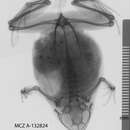fr
noms dans le fil d’Ariane


Copiula derongo is a species of frog in the family Microhylidae. It is endemic to New Guinea and found in both Indonesia and Papua New Guinea.[1][3] The specific name derongo refers to its type locality, the village of Derongo in the Western Province (Papua New Guinea).[2] Based on molecular evidence, it was transferred from Austrochaperina to Copiula in 2016.[3][4]
Males measure up to 37 mm (1.5 in) and females up to 50 mm (2.0 in) in snout–vent length, although the maximum size varies geographically. The dorsal ground colour is olive to reddish brown, sometimes with dark speckles. In most males (and in some females) the tip of the snout is much paler than the rest of the head. The eyes are small and the tympanum is obscure.[2]
Its natural habitats are tropical forests. It breeds in mud cavities. It is locally common and occurs in remote areas with little human influence, and is therefore not considered threatened.[1]
Copiula derongo is a species of frog in the family Microhylidae. It is endemic to New Guinea and found in both Indonesia and Papua New Guinea. The specific name derongo refers to its type locality, the village of Derongo in the Western Province (Papua New Guinea). Based on molecular evidence, it was transferred from Austrochaperina to Copiula in 2016.
Copiula derongo es una especie de anfibio anuro de la familia Microhylidae. Es una rana endémica de la isla de Nueva Guinea, donde se distribuye por la región de la cordillera Central en Papúa Nueva Guinea e Indonesia. Habita en selvas tropicales entre los 80 y 1520 metros de altitud. Se reproduce por desarrollo directo y pone alrededor de 14 huevos en agujeros en el barro.[1]
Copiula derongo es una especie de anfibio anuro de la familia Microhylidae. Es una rana endémica de la isla de Nueva Guinea, donde se distribuye por la región de la cordillera Central en Papúa Nueva Guinea e Indonesia. Habita en selvas tropicales entre los 80 y 1520 metros de altitud. Se reproduce por desarrollo directo y pone alrededor de 14 huevos en agujeros en el barro.
Austrochaperina derongo Austrochaperina generoko animalia da. Anfibioen barruko Microhylidae familian sailkatuta dago, Anura ordenan.
Austrochaperina derongo Austrochaperina generoko animalia da. Anfibioen barruko Microhylidae familian sailkatuta dago, Anura ordenan.
Copiula derongo est une espèce d'amphibiens de la famille des Microhylidae[1].
Cette espèce est endémique de Nouvelle-Guinée. Elle est présente entre 80 et 1 520 m d'altitude[1],[2].
Copiula derongo mesure jusqu'à 37 mm pour les mâles et jusqu'à 42 mm pour les femelles[3].
Son nom d'espèce, derongo, lui a été donné en référence à Derongo, le village dont proviennent de nombreux spécimens de cette espèce.
Copiula derongo est une espèce d'amphibiens de la famille des Microhylidae.
Copiula derongo é uma espécie de anfíbio da família Microhylidae.
Pode ser encontrada nos seguintes países: Indonésia e Papua-Nova Guiné.[1]
Os seus habitats naturais são: florestas subtropicais ou tropicais húmidas de baixa altitude, regiões subtropicais ou tropicais húmidas de alta altitude e rios.[1]
Copiula derongo é uma espécie de anfíbio da família Microhylidae.
Pode ser encontrada nos seguintes países: Indonésia e Papua-Nova Guiné.
Os seus habitats naturais são: florestas subtropicais ou tropicais húmidas de baixa altitude, regiões subtropicais ou tropicais húmidas de alta altitude e rios.